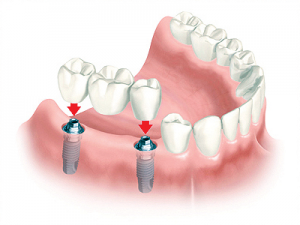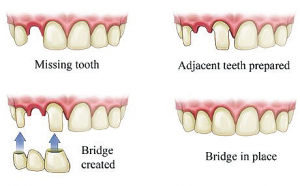By Dr. Salina Suy
 Editor’s note: This is another segment is a continuing series titled, “Defining Dentistry,” designed to enlighten readers on various components of dentistry.
Editor’s note: This is another segment is a continuing series titled, “Defining Dentistry,” designed to enlighten readers on various components of dentistry.
Happy March and it’s almost the end of winter!
I swear our winters get more and more unpredictable. I am from Buffalo, so this weather is cake!
I hope you all are finding ways to stay fit and healthy. I love going to the gym in the winter. What do you like to do?
Thank you again for joining in on this month’s “Smile with Dr. Suy” and our continuing series, “Defining Dentistry.”
What is a dental bridge?
A dental bridge is a dental prosthetic that literally bridges or connects your teeth together. You can see more about a dental bridge, the importance of the bridge, and its procedure in this article.
Natural teeth or dental implants can support bridges.
A bridge is made up of two or more crowns on either side of the missing tooth area. These teeth anchor the bridge to the mouth.
In between the anchoring teeth are false floating teeth, called pontics, which replace the missing teeth. Bridges can replace one or more missing teeth. They stay in the mouth and do not require to be taken in and out like dentures. Bridges can be made of metal or different ceramic substrates. Go on the page here to get help with your dental queries and issues.
Why would I need a bridge?
If you are missing one or more teeth, you might need a bridge. When I am examining my patient, I usually look at the teeth surrounding the missing teeth area and plan from there.
Typically, it’s recommended to have a clinical and X-ray examination. If the teeth surrounding the missing teeth site are all very healthy and untouched, I typically will recommend a dental implant since this does not require preparation of those teeth. Dental implants are among the most popular dental restoration options available, due to their natural appearance and durable construction. A dental implant is a prosthetic root made of titanium that is placed into the jawbone and serves as an anchor for replacement teeth. Here are some signs you may need dental implants.
If teeth are previously crowned, have decay or previous root canal treatment, I am more likely to recommend a conventional dental bridge. If more than one tooth is missing and the areas are spread apart from one another, I may recommend a denture or several bridges or Instasmile fake front teeth.
Patients with active periodontal disease and severe cavities should not get bridges until these problems are resolved. These treatment plan considerations are just a few dentists have in mind when recommending your proper treatment.
What is the procedure for a bridge?
 Depending on if your bridge is tooth supported or implant supported, the procedure for a bridge will be different. If you have natural teeth, your dentist will prepare the teeth and make room for the bridge material. If you have dental implants, abutments will be made with space for your bridge. Once this step is complete, the bridge procedure is the same.
Depending on if your bridge is tooth supported or implant supported, the procedure for a bridge will be different. If you have natural teeth, your dentist will prepare the teeth and make room for the bridge material. If you have dental implants, abutments will be made with space for your bridge. Once this step is complete, the bridge procedure is the same.
An impression of the anchoring teeth or implant abutments will be made. This can be done digitally or with impression material.
This impression is then sent to a laboratory where they will take this information and fabricate a bridge according to your dentist prescriptions. Some prosthetic dentistry professionals even have units that make bridges in their office, but this depends on the technology and materials on hand.
Once the bridge is back, your dentist will see how it fits. Once it is adjusted to clinical standards, your bridge will be cemented in your mouth.
I have a bridge, now what?
Congratulations, you now have a wonderful new prosthetic in your mouth that could last you a long time. Like anything else in the mouth, dental bridges are subject to dental decay and should be taken care of.
Special oral hygiene instructions for bridges include bridge flossing and using a Waterpik®. Bridge flossers allow patients to go underneath pontic sites to clean underneath the bridge. Waterpiks® help flush out underneath pontic sites as well and surrounding mouth structures. You can check dental guides and reviews on Dental Pickup.
Hopefully, this column has helped bridge the gap regarding your knowledge of dental bridges!
Have some questions to ask me in person? Call 315-724-3197 for a free consultation. I look forward to meeting you!

